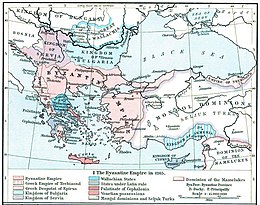Battle of Settepozzi
| Battle of Settepozzi | |||||||
|---|---|---|---|---|---|---|---|
| Part of the War of Saint Sabas and the Byzantine–Latin Wars |
|||||||
 Map of the Byzantine Empire and the surrounding states in 1265 |
|||||||
|
|||||||
| Belligerents | |||||||
|
|
|
||||||
| Commanders and leaders | |||||||
|
|
(4 admirals in total) |
||||||
| Strength | |||||||
| 32 galleys | 38 galleys 10 saettie (only 14 engaged) |
||||||
| Casualties and losses | |||||||
| 20 killed 400 wounded |
600 killed 400 captured 4 galleys lost |
||||||
The Battle of Settepozzi was fought sometime in May–July 1263 off Settepozzi (the Italian name for Spetses) between a Genoese-Byzantine fleet and a smaller Venetian fleet. The resulting Venetian victory had important political repercussions, as the Byzantines distanced themselves from their alliance with Genoa and restored their relations with Venice.
In early July 1261, the Nicaean emperor Michael VIII Palaiologos (r. 1259–1261) had allied himself with the Genoese in the Treaty of Nymphaeum. This alliance, whose terms were very advantageous to Genoa, was necessary for the Nicaeans and their aim of successfully recovering Constantinople, the seat of the moribund Latin Empire. The Latin emperors were backed by the naval might of Venice (with whom Genoa was already at war), and without a strong navy to counter it, the city would not fall, as two previous attempts in 1235 and 1260 had demonstrated.
In the event, the city was recovered by Alexios Strategopoulos barely a fortnight after the treaty was signed, without the need for Genoese naval aid. For a year thereafter, both Venice and Genoa remained rather passive. Venice hesitated to confront the numerically far superior fleet that Genoa had dispatched in the Aegean and awaited political developments in the West, while Genoa suffered from internal turmoil with the deposition of the autocratic Captain of the People Marino Boccanegra and the assumption of power by a collective leadership from among the noble houses. In summer 1262, the Venetians ordered a 37-galley fleet into the Aegean, which met the Genoese fleet of 60 ships at Thessalonica, but the Genoese refused to engage. A piratical foray, however, by the nobles of Negroponte, allied with Venice, into the Marmara Sea was confronted and defeated by a Byzantine-Genoese squadron.
...
Wikipedia
